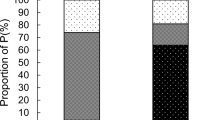Summary
The extent and the mechanism of phytic acid decomposition in germinating wheat grain of a low-yielding and a high-yielding wheat variety have been investigated.
While in the high-yielding variety this decomposition was most important on the first, fifth, and seventh day of germination, in the low-yielding variety extensive decomposition began only on the second day and reached its maximum value on the fifth day of germination. If one accepts the criterion of Mellanby for the rate of phytic acid decomposition, it appears that phytic acid is completely decomposed within seven days in the high-yielding variety and within six days in the low-yielding variety. The increase of free orthophosphate was not equivalent to the decrease of phytic acid, the difference representing the amount of orthophosphate phosphorus uptake in oxidative and photosynthetic phosphorylation.
It was found that enzymatic hydrolysis of phytic acid in germinating wheat grain occurred stepwise, by the successive liberation of phosphoric acid and through the intermediate formation of penta-, tetra-, tri-, di-, and monophosphates of inositol, the final products being inositol and phosphoric acid. In ripe wheat grain before germination, only inositol hexaphosphate (phytic acid) was present.
Similar content being viewed by others
References
Anderson, G., Identification and estimation of soil inositol phosphates. J. Sci. Food Agr.7 437–444 (1956).
Ashton, W. M. and Williams, P. C., The phosphorus compounds of oats. I. The content of phytate phosphorus. J. Sci. Food Agr.9 505–511 (1958).
Bandurski, R. S. and Axelrod, B., The chromatographic identification of some biologically important phosphate esters. J. Biol. Chem193 405–410 (1951).
Courtois, J., Les esters phosphoriques de l'inositol. Bull. Soc. Chim. Biol.33 1075–1112 (1951).
Desjobert, A. and Fleurent, P., Influence de la reaction du mileen sur l'hydrolyse chimique de l'inositol-hexaphosphate. Considerations sur la constitution de ce derivé. Bull. Soc. Chim. Biol.36 475–482 (1954).
Desjobert, A. and Petek, F., Étude de la marche de la degradation hydrolytique de l'inositolhexaphosphate par chromatographie sur papier. Compt.rend.241 1343–1345 (1955).
Fischler, F., Alkaline earth salts of inositol tetraphosphate. Chem. Abstr.34 2394 (1940).
Hanes, C. S. and Isherwood, F. A., Separation of the phosphoric esters on the filter paper chromatogram. Nature164 1107–1112 (1949).
Mellanby, E., A Story of Nutritional Research. 1th ed., pp. 261 and 264. The Williams and Wilkins Co., Baltimore (1950).
Mihailović, M. Lj., Antić, M. and Hadžijev, D., Chemical Investigation of wheat. 1. Dynamics of various forms of phosphorus in wheat during its ontogenesis. I. Accumulation forms of phosphorus in ripe wheat grain. Orthophosphate and total phosphorus. Glasnik hem. drušstva Beograd (Bull. Soc. Chim. Beograd)27 117–133 (1962).
Mihailović, M. Lj., Antić, M. and Hadžijev, D., Chemical investigation of wheat. 2. Dynamics of various forms of phosphorus in wheat during its ontogenesis. II. Accumulation forms of phosphorus in ripe wheat grain. Phytic acid phosphorus. Glasnik hem. društva Beograd (Bull. Soc. Chim. Beograd)27 135–155 (1962).
Patten, A. J. and Hart, E. B., The nature of the principal phosphorus compound in wheat bran. Am. Chem. J.31 564–572 (1904).
Peers, F. G., The phytase of wheat. Biochem. J.53 102–110 (1953).
Posternak, S. and Posternak, T., Sur la configuration de l'inosite inactive. Helvetia Chim. Acta12 1165–1181 (1929).
Preece, I. A., Grav, H. J. and Wadham, A. T., Studies on phytin. I. Inositol phosphates. J. Inst. Brewing66 487–494 (1960).
Schormüller, J. and Würdig, G., Über die Trennung und Identifizierung der Inosit phosphorsaureester durch Papierchromatographie. Z. Lebensm. Untersuch. u. Forsch.105 397–403 (1957).
Schormüller, J., Würdig, G. and Bressau, G., Phosphate und organische Phosphorverbindungen in Lebensmitteln. IV. Mitt. Über des Vorkommen von Spaltprodukten der Phytinsaure in Samerien, Getreide produkten und Weizenmaische. Z. Lebensm. Untersuch. u. Forsch.109 297–301 (1959).
Schormüller, J., Würdig, G. and Bressau, G., Phosphate und organische Phosphorverbindungen in Lebensmitteln. III. Mitt. Üntersuchungen über Weizenphytase sowie über den enzymatischen und säurehidrolitischen Abbau des Phytins. Z. Lebensm. Untersuch. u. Forsch.109 378–386 (1959).
Smith, D. H. and Clark, F. E., Chromatographic separations of inositol phosphorus compounds. Soil Sci. Soc. Am. Proc.16 170–172 (1952).
Wade, H. E. and Morgan, D. M., Fractionation of phosphates by paper ionophoresis and chromatography. Biochem. J.60 264–270 (1955).
Author information
Authors and Affiliations
Additional information
Paper 7: Glasnik hem. drustva (Beograd (Bull. soc. chim. Beograd)),28, 303–325 (1963)
Rights and permissions
About this article
Cite this article
Mihailovic, M., Antić, M. & Hadžijev, D. Chemical investigation of wheat. Plant Soil 23, 117–128 (1965). https://doi.org/10.1007/BF01349122
Received:
Issue Date:
DOI: https://doi.org/10.1007/BF01349122



